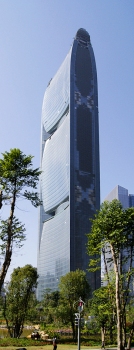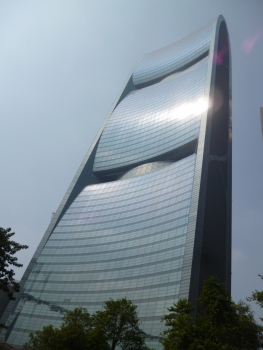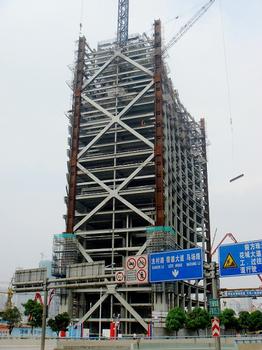General Information
| Name in local language: | 珠江城大厦 (Zhūjiāng chéng dàshà); 珠江大厦 (Zhūjiāng dàshà) |
|---|---|
| Other name(s): | Guangdong Tobacco Building |
| Beginning of works: | 28 September 2006 |
| Completion: | March 2011 |
| Status: | in use |
Project Type
| Function / usage: |
Office building |
|---|---|
| Material: |
Composite structure |
| Energy efficiency: |
for registered users |
Location
Technical Information
Dimensions
| height | 309.40 m | |
| number of floors (above ground) | 71 | |
| site area | 10 635 m² | |
| number of floors (below ground) | 5 | |
| gross floor area | 204 000 m² | |
| gross floor area | 154 840 m² | |
| number of parking spaces | 852 | |
| elevators | number | 29 |
Materials
| columns |
steel girders encased in concrete
|
|---|---|
| floor beams |
steel
|
| building core |
reinforced concrete
|
Chronology
| October 2005 | Design competion. |
|---|---|
| 26 September 2006 | Groundbreaking. |
| 18 July 2007 | Public tender for the construction of the skyscraper. |
| November 2009 | Installation of the glass curtain wall begins. |
| December 2009 | The building height reaches the level of the wind turbine. |
| 28 March 2010 | The building is topped out. |
Excerpt from Wikipedia
Pearl River Tower (Chinese: 珠江城大厦; pinyin: Zhūjiāng chéng dàshà; or Chinese: 珠江大厦; pinyin: Zhūjiāng dàshà) is a 71-story, 309.6 m (1,016 ft), clean technology neofuturistic skyscraper at the junction of Jinsui Road/Zhujiang Avenue West, Tianhe District, Guangzhou, China. The tower's architecture and engineering were performed by Skidmore, Owings & Merrill with Adrian D. Smith and Gordon Gill (now at their own firm, AS+GG) as architects. Ground broke on the tower on 8 September 2006 and construction was completed in March 2011. It is intended for office use and is partially occupied by the China National Tobacco Corporation.
Architecture and design
The design of the Pearl River Tower is intended to minimise harm to the environment and it will extract energy from the natural and passive forces surrounding the building. Major accomplishments are the technological integration of form and function in a holistic approach to engineering and architectural design.
Sustainability
The building is designed with energy conservation in mind, including wind turbines and solar collectors, photovoltaic cells, underfloor air distribution, and radiant heating and cooling ceilings. It is one of the most environmentally friendly buildings in the world.
Of Pearl River Tower’s accomplishments, many are related to the sustainable design features include:
- The largest radiant-cooled office building in the world
- Most energy efficient super-tall building in the world
- The tower is an example of China’s goal to reduce the intensity of carbon dioxide emissions per unit of GDP in 2020 by 40 to 45 percent as compared to the level of 2005.
In a report presented at the 2008 Council on Tall Buildings and Urban Habitat it was reported that the building's sustainable design features will allow a 58% energy usage reduction when compared to similar stand alone buildings. The building would have been able to be carbon neutral and actually sell power back to the surrounding neighborhood if the micro-turbines had been installed into the building. However the local power company in Guangzhou does not allow independent energy producers to sell electricity back to the grid. Without the financial incentive to add the micro-turbines the developers removed them from the design. If they had been added excess power would have been produced from the building, at the very least, after office hours when the power needed by the building itself had been reduced.
Timeline
- Fall 2005 : Design Competition
- 8 September 2006 : Ground Breaking Ceremony
- November 2006 : Enabling Works begin
- 18 July 2007 : Public bidding for the construction
- January 2008 : Main Package construction begins −26.2 m (−86 ft)
- August 2008 : Building Core construction reaches ground level 0 m (0 ft)
- April 2009 : 15th Level 80.6 m (264 ft)
- November 2009: Glass curtainwall installation begins
- December 2009: Building reaches upper wind turbine level
- 28 March 2010: Topped-out
Text imported from Wikipedia article "Pearl River Tower" and modified on July 23, 2019 according to the CC-BY-SA 4.0 International license.
Participants
-
Skidmore, Owings & Merrill
- Adrian D. Smith (architect)
-
Skidmore, Owings & Merrill
- William F. Baker (structural engineer)
Relevant Web Sites
- About this
data sheet - Structure-ID
20058652 - Published on:
14/10/2010 - Last updated on:
22/04/2020








